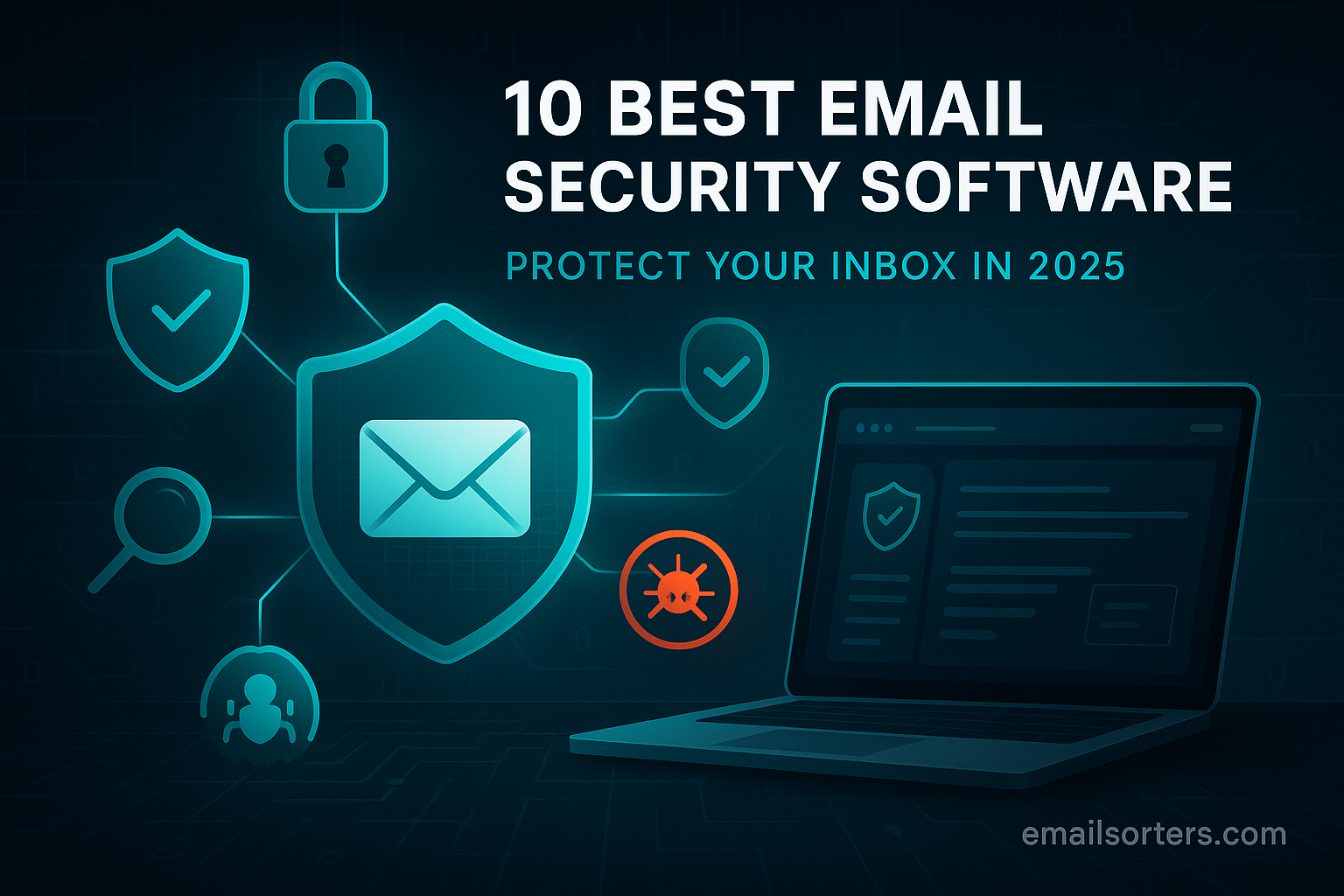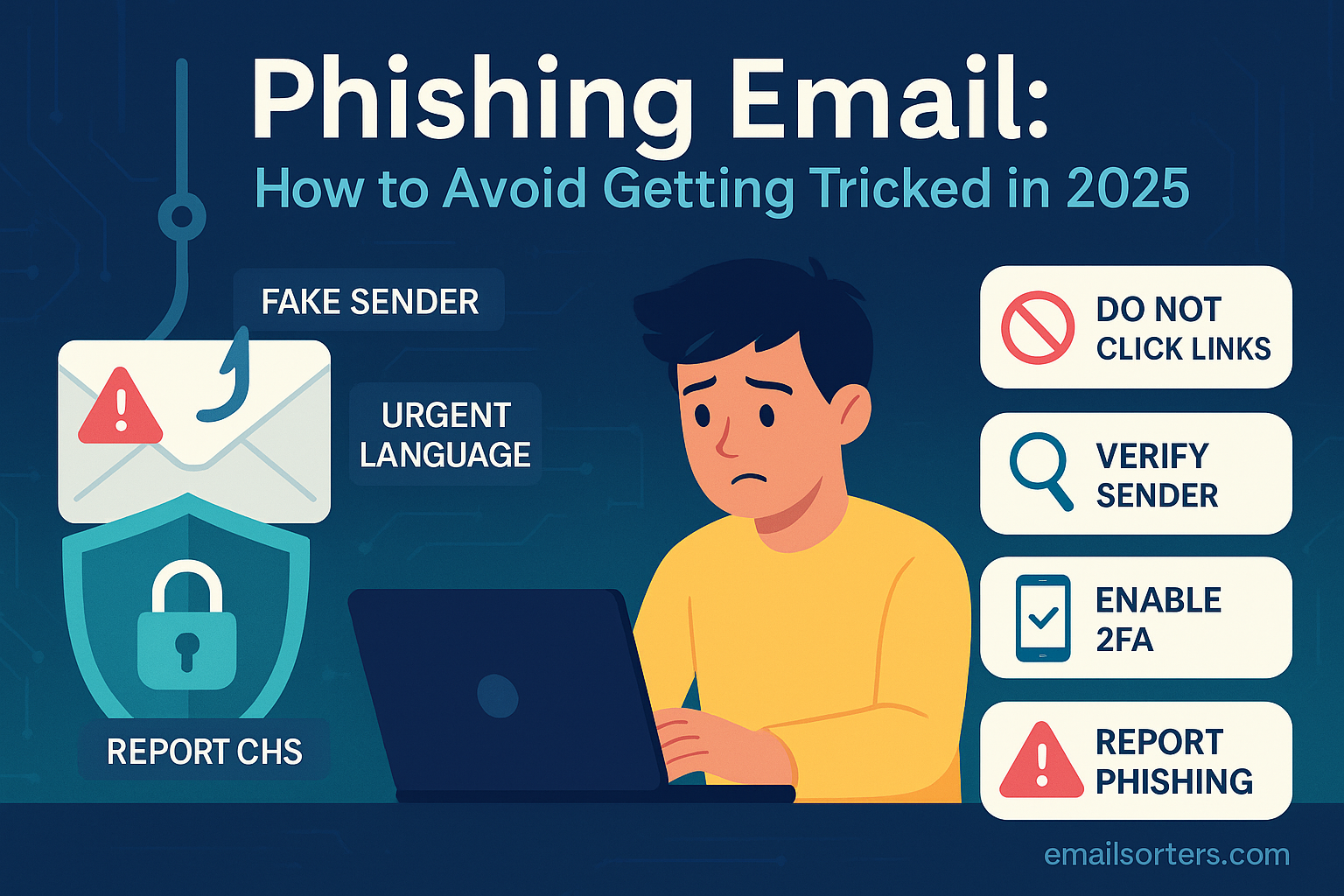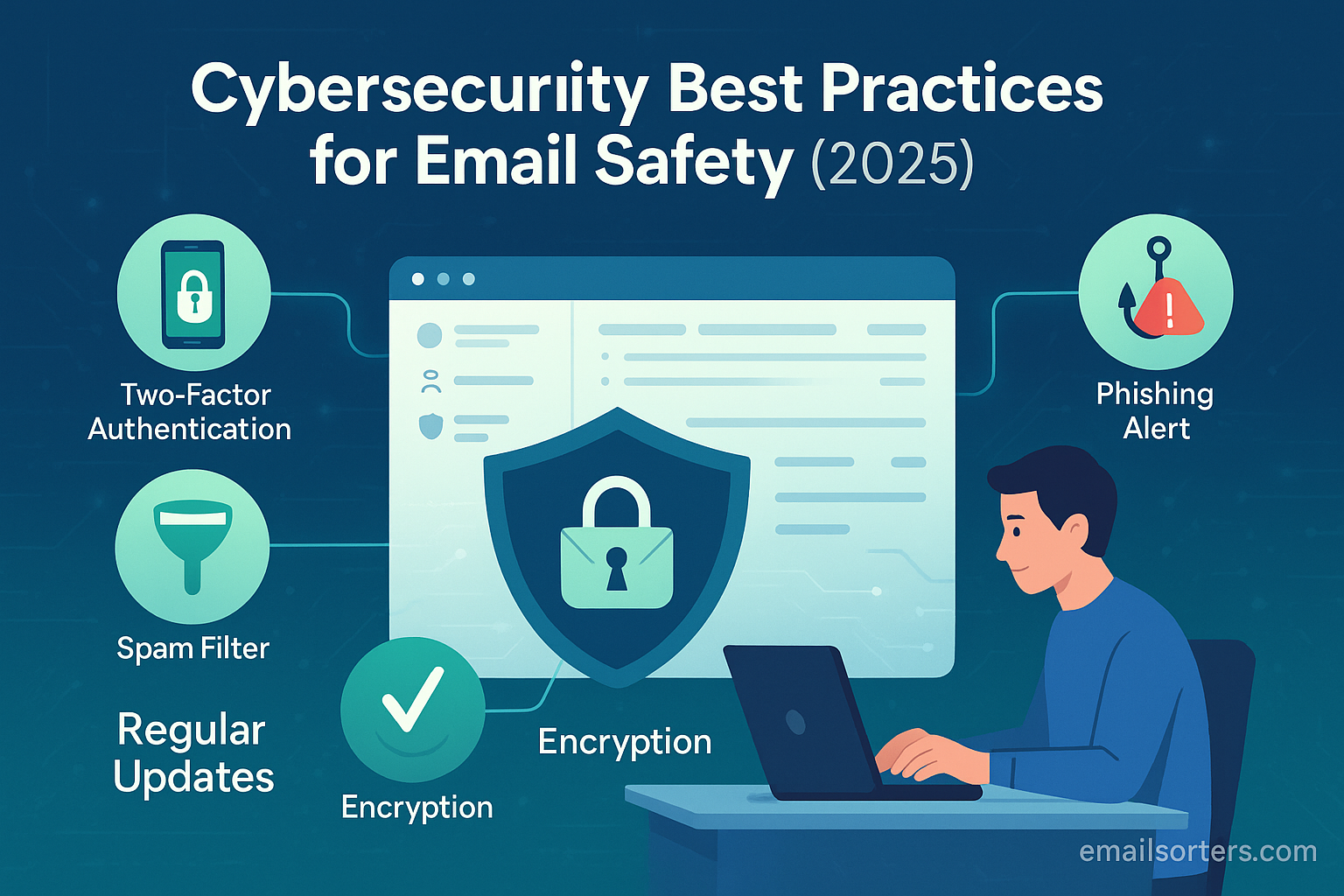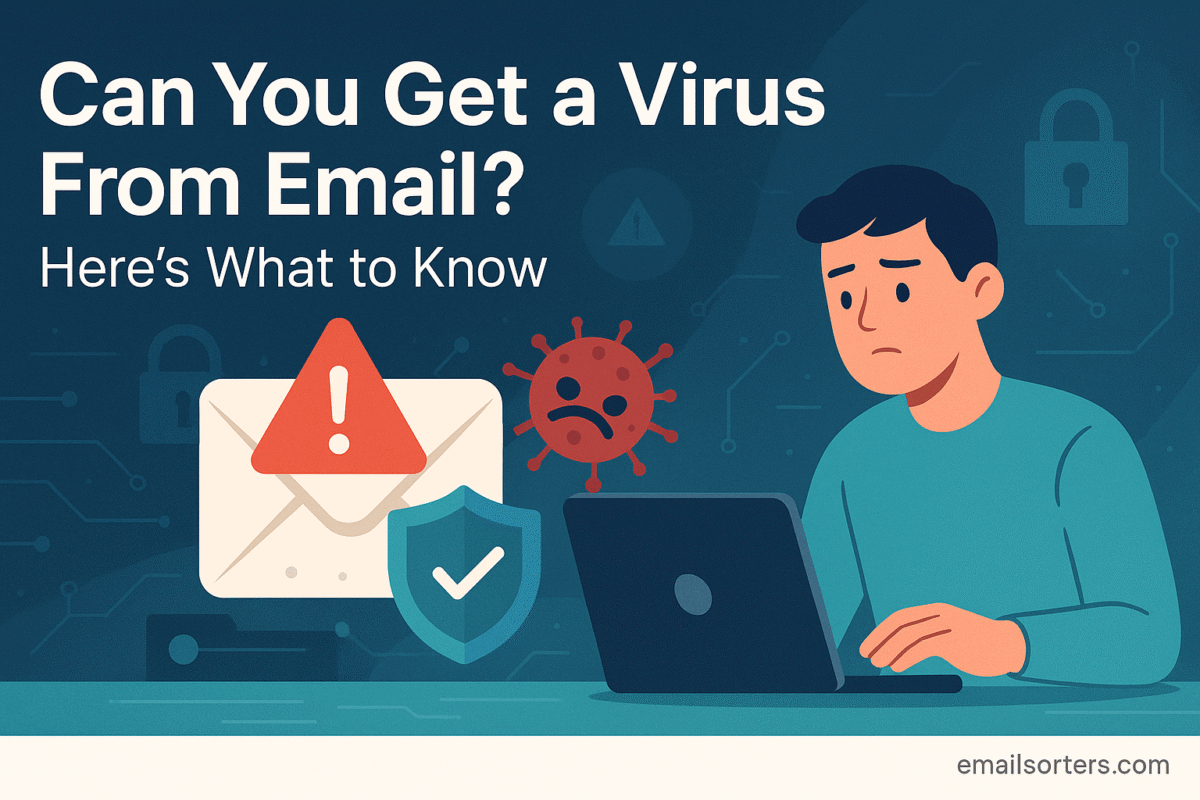Best email security software isn’t just a “nice to have” in 2025, it’s essential. Email keeps businesses running, from internal teamwork to high-stakes client deals. But it’s also the number one way cybercriminals slip in, delivering malware, ransomware, and data breaches that can cost millions.
The interest in advanced email protection is no longer a niche concern for IT departments; it is a core business imperative. Organizations now face a barrage of highly targeted threats, including Business Email Compromise (BEC), spear-phishing campaigns, and zero-day exploits that can bypass conventional defenses.
This has fueled the evolution of specialized email security software designed to provide a multi-layered defense against these advanced attacks. The broader context of this need is rooted in the fundamental principles of email privacy, which dictates that communications should be confidential and protected from unauthorized interception.
The desire for a truly secure email environment—one that is resilient, intelligent, and capable of neutralizing threats before they reach an employee’s inbox—is now achievable. A new generation of security solutions offers the robust protection needed to safeguard your organization’s most valuable asset: its data.
This guide provides an authoritative, in-depth review of the 10 best email security software solutions for 2025, offering the clarity needed to help you select the right platform to fortify your digital communications against the challenges of tomorrow.
Why Email Security is Non-Negotiable in 2025
The email threat landscape has evolved far beyond simple spam. In 2025, organizations face highly personalized and socially engineered attacks that are designed to trick even cautious employees. Business Email Compromise (BEC) attacks, where attackers impersonate executives to authorize fraudulent wire transfers, are now a multi-billion dollar problem. Ransomware is frequently delivered via malicious email attachments or links, capable of paralyzing an entire organization in minutes. Furthermore, supply chain attacks can compromise a trusted partner’s email account, using it as a launchpad to attack your own business. These factors make a dedicated email security solution an essential component of any modern cybersecurity strategy.
Criteria for Evaluating Email Security Software
Choosing the right software requires a clear understanding of the key features that provide comprehensive protection. The best solutions excel in the following areas:
- Threat Detection and Prevention: This is the core function. The software must have advanced capabilities to detect and block phishing, spear-phishing, malware, ransomware, and BEC attacks using a combination of signature-based detection, behavioral analysis, and sandboxing.
- Data Loss Prevention (DLP): A robust DLP engine scans outbound emails and attachments to identify and block the unauthorized transmission of sensitive data, such as credit card numbers, intellectual property, or personal health information.
- Encryption and Authentication: The solution should support strong encryption for sensitive emails (e.g., OME, S/MIME) and enforce email authentication standards like DMARC, DKIM, and SPF to prevent domain spoofing.
- Integration and Administration: It must integrate seamlessly with leading email platforms like Microsoft 365 and Google Workspace. A centralized, user-friendly management console is crucial for setting policies, monitoring threats, and generating reports.
- Post-Delivery Protection: Advanced solutions offer the ability to retract or “claw back” malicious emails that have already been delivered to a user’s inbox, neutralizing a threat before it can be acted upon.
The Top 10 Email Security Software Solutions for 2025
The following platforms represent the best-in-class solutions for email security, each offering a unique combination of features tailored to different organizational needs.
1. Mimecast Secure Email Gateway
Overview: Mimecast is a long-standing leader in the email security and archiving space, known for its comprehensive, all-in-one cloud platform. It provides a robust suite of tools that go beyond threat protection to include archiving, continuity, and compliance.
- Key Features: Advanced threat protection against phishing and BEC, content and DLP controls, secure messaging portal, 100% email uptime SLA (continuity), and a massive cloud archive for e-discovery and compliance.
- Pros: Highly integrated platform reduces vendor complexity. Its email continuity feature is a major differentiator, ensuring email remains operational even during a primary server outage. Strong brand reputation and a massive threat intelligence network.
- Cons: The sheer number of features can make the platform complex to manage initially. Pricing can be on the higher end compared to simpler solutions.
- Ideal User: Mid-sized to large enterprises, particularly those in regulated industries like finance and law that require strong archiving and compliance features alongside top-tier security.
- Pricing Model: Per-user, per-month subscription, typically sold in bundles.
- 2025 Relevance: Mimecast’s continued investment in its threat intelligence grid and its integrated approach make it a resilient choice against the multi-faceted attack campaigns prevalent in 2025.
2. Proofpoint Email Security and Protection
Overview: Proofpoint is another dominant force in enterprise email security, trusted by a large percentage of Fortune 1000 companies. Its strength lies in its highly effective threat detection, powered by a people-centric approach that identifies Very Attacked People (VAPs) within an organization.
- Key Features: Multi-layered detection for malware and non-malware threats, advanced BEC and supplier impersonation defense, email authentication (DMARC), threat isolation (browser isolation), and detailed threat intelligence.
- Pros: Widely regarded as having one of the most effective threat detection engines on the market. Its people-centric view provides unique insights into organizational risk. Excellent for large, complex enterprise environments.
- Cons: Can be a costly solution, often more suitable for large enterprises than SMBs. The platform can be complex to deploy and manage without dedicated IT resources.
- Ideal User: Large enterprises and organizations that are high-value targets for cybercriminals and require the absolute best in threat detection and intelligence.
- Pricing Model: Per-user subscription model.
- 2025 Relevance: As attacks become more personalized, Proofpoint’s focus on identifying and protecting the most targeted individuals within an organization is more relevant than ever.
3. Cisco Secure Email (formerly Email Security Appliance)
Overview: Leveraging its massive global threat intelligence network (Talos), Cisco Secure Email offers powerful threat defense for organizations of all sizes. It is available as a cloud service, a physical appliance, or a virtual appliance, providing flexible deployment options.
- Key Features: Advanced malware protection (AMP), sandboxing, BEC detection, DLP, end-to-end encryption, and real-time threat intelligence from Cisco Talos.
- Pros: Unmatched threat intelligence from one of the world’s largest security companies. Flexible deployment options cater to different IT environments. Strong integration with the broader Cisco security ecosystem.
- Cons: The user interface for the appliance-based versions can feel dated compared to cloud-native competitors. Some advanced features may require separate licenses.
- Ideal User: Organizations already invested in the Cisco ecosystem, as well as businesses looking for flexible hybrid or on-premises deployment options.
- Pricing Model: Subscription-based licensing, varies by deployment model.
- 2025 Relevance: Its ability to integrate email security with network and endpoint security provides a holistic defense that is critical for combating multi-channel attacks.
4. Barracuda Email Protection (formerly Essentials)
Overview: Barracuda offers a comprehensive and accessible email protection suite that is particularly popular with small and medium-sized businesses (SMBs). It combines gateway security, inbox defense, data protection, and security awareness training into a single, easy-to-manage platform.
- Key Features: Inbound/outbound filtering for spam and malware, Advanced Threat Protection (sandboxing), email archiving, cloud-to-cloud backup for Microsoft 365, and integrated phishing simulation and training.
- Pros: Excellent value for the price, making enterprise-grade security accessible to SMBs. The all-in-one approach including backup and training is highly convenient. Easy to deploy and manage.
- Cons: While highly effective, its threat detection may not be as sophisticated at the absolute high end as specialized enterprise leaders like Proofpoint.
- Ideal User: Small and medium-sized businesses looking for a comprehensive, easy-to-use, and cost-effective email security and data protection solution.
- Pricing Model: Per-user, per-month subscription.
- 2025 Relevance: Barracuda’s focus on integrating security awareness training directly into its platform addresses the critical human element of cybersecurity, a key vulnerability in 2025.
5. Avanan (A Check Point Company)
Overview: Avanan takes a different approach from traditional gateways. It is an API-based solution that integrates directly into the cloud email environment (Microsoft 365 and Google Workspace). This allows it to analyze emails after the default security filters have run, providing an additional layer of defense against threats that get through.
- Key Features: API-based deployment for post-delivery protection, BEC and phishing detection, malware sandboxing, DLP, and protection for other collaboration tools like Teams and Slack.
- Pros: Catches threats that traditional gateways miss. Deployment is exceptionally fast (often under 10 minutes). Protects internal, east-west email traffic, a common blind spot for gateways.
- Cons: As an API solution, it is entirely dependent on the cloud email provider. It is not suitable for on-premises email environments.
- Ideal User: Cloud-first organizations using Microsoft 365 or Google Workspace that want to add a powerful, modern security layer on top of the native defenses.
- Pricing Model: Per-user, per-month subscription.
- 2025 Relevance: Its API-first model is perfectly suited to the modern cloud-centric workplace and is highly effective against internal threats and account takeovers.
6. Abnormal Security
Overview: Abnormal Security is another leading API-based solution that focuses specifically on the most sophisticated and hard-to-detect email attacks, particularly Business Email Compromise. It uses behavioral data science to create a baseline of known-good behavior for every employee and vendor, flagging any anomalies.
- Key Features: Advanced BEC and vendor email compromise detection, account takeover protection, behavioral analysis, and seamless integration with Microsoft 365 and Google Workspace.
- Pros: Exceptionally high detection rate for advanced, socially engineered threats that other tools miss. Very easy to deploy and requires minimal ongoing administration.
- Cons: It is a highly specialized tool focused on advanced threats, not a full replacement for a secure email gateway that also handles bulk spam and malware. Often used in conjunction with another security layer.
- Ideal User: Enterprises that are prime targets for BEC and want a best-in-class solution to stop these highly damaging, low-volume attacks.
- Pricing Model: Per-employee subscription.
- 2025 Relevance: As BEC attacks continue to evade traditional defenses, Abnormal’s behavioral analysis approach represents the cutting edge of threat detection.
7. Trellix Email Security (formerly FireEye)
Overview: Trellix, formed from the merger of McAfee Enterprise and FireEye, offers a powerful email security solution backed by deep expertise in threat intelligence and incident response. It excels at detecting and analyzing advanced, unknown threats.
- Key Features: Multi-vector threat detection, advanced URL and attachment analysis, sandboxing, and deep integration with the broader Trellix XDR (Extended Detection and Response) platform.
- Pros: Backed by world-class threat research and intelligence. Strong at identifying zero-day exploits and advanced persistent threats (APTs).
- Cons: The platform can be complex and is geared towards organizations with mature security operations centers (SOCs).
- Ideal User: Large enterprises and government agencies with dedicated security teams that need to defend against the most sophisticated, state-sponsored or high-level cybercriminal groups.
- Pricing Model: Subscription-based, often part of a larger platform sale.
- 2025 Relevance: Its strength in zero-day detection is critical as attackers increasingly use novel malware to bypass signature-based security tools.
8. Fortinet FortiMail
Overview: FortiMail is a secure email gateway from Fortinet, a leader in network security. It leverages threat intelligence from FortiGuard Labs and integrates tightly with the Fortinet Security Fabric, allowing for a coordinated response across network, endpoint, and email security layers.
- Key Features: Inbound and outbound filtering, advanced threat protection (sandboxing, content disarm and reconstruction), DLP, email encryption, and archiving.
- Pros: Excellent integration for organizations already using Fortinet’s FortiGate firewalls. Offers a compelling total cost of ownership. Available as an appliance, VM, or cloud service.
- Cons: It provides the most value when used as part of the broader Fortinet ecosystem; as a standalone product, other solutions may be more feature-rich.
- Ideal User: Organizations of all sizes that are current Fortinet customers or those looking to build out a new, highly integrated security infrastructure.
- Pricing Model: Appliance purchase plus subscription services.
- 2025 Relevance: The emphasis on integrated security fabric is key to achieving the automated, rapid threat response needed in today’s environment.
9. Sophos Email Security
Overview: Sophos Email Security is a cloud-based solution that integrates with Sophos’s broader ecosystem of cybersecurity products, including its industry-leading endpoint protection. It offers a strong, synchronized security approach.
- Key Features: Phishing and malware protection, BEC detection, post-delivery protection (email retraction), DLP, and S/MIME encryption. Its “Synchronized Security” feature links email security with endpoint security for better context and response.
- Pros: The integration with Sophos Central and endpoint products is a major advantage, providing visibility and control from a single platform. User-friendly interface.
- Cons: Its most powerful features are realized when used in conjunction with other Sophos products.
- Ideal User: Businesses of all sizes, especially those already using or planning to use Sophos Intercept X for endpoint protection.
- Pricing Model: Per-user, per-year subscription.
- 2025 Relevance: Synchronized security is a key trend, and Sophos’s ability to correlate email threats with endpoint activity provides a powerful defense against complex attacks.
10. Egress Intelligent Email Security
Overview: Egress focuses on preventing human-activated risks. Its platform uses intelligent analysis to prevent breaches caused by human error, such as sending an email to the wrong person (mis-delivery) or failing to encrypt sensitive data.
- Key Features: Outbound email security, DLP, encryption, and protection against mis-addressed emails. It also offers inbound phishing and BEC defense.
- Pros: Uniquely strong at preventing outbound data breaches caused by human error, a common compliance and security gap. The user prompts and warnings are highly effective at changing employee behavior.
- Cons: Its primary strength is outbound protection; for inbound threat detection, other platforms may be more comprehensive.
- Ideal User: Organizations in highly regulated industries like healthcare, legal, and finance where preventing accidental data leakage is a top priority.
- Pricing Model: Per-user subscription.
- 2025 Relevance: As data privacy regulations become stricter, Egress’s focus on preventing human error-driven data loss is an increasingly critical component of a complete security strategy.
A Holistic Approach: Software Plus Strategy
Implementing one of these powerful software solutions is a critical first step, but technology alone is not a silver bullet. Maximum security is achieved when these tools are combined with robust processes and a security-aware culture. The best email security platform serves as the foundation for a broader strategy that includes regular employee training on phishing identification and other cybersecurity best practices.
While these suites are far more advanced than simple spam blockers, their effectiveness is magnified when users understand the principles of secure email sending. This knowledge empowers them to use the encryption and data protection features of the chosen software intelligently, making them an active participant in the organization’s defense.
Comparison at a Glance
| Software | Key Strength | Ideal User | Pricing Model |
| Mimecast | Integrated Security, Archiving & Continuity | Mid-to-Large Enterprises (Regulated Industries) | Per-User Subscription |
| Proofpoint | Best-in-Class Threat Detection & Intelligence | Large Enterprises (High-Value Targets) | Per-User Subscription |
| Cisco Secure Email | Massive Threat Intelligence & Deployment Flexibility | Organizations in the Cisco Ecosystem | Subscription (Varies by Model) |
| Barracuda | All-in-One Security, Backup & Training | Small to Medium-Sized Businesses (SMBs) | Per-User Subscription |
| Avanan | API-Based, Post-Delivery Protection | Cloud-First Orgs (Microsoft 365 / Google) | Per-User Subscription |
| Abnormal Security | Behavioral Analysis for Advanced BEC | Enterprises Targeted by Social Engineering | Per-Employee Subscription |
| Trellix | Zero-Day & Advanced Threat Detection | Enterprises with Mature SOCs | Subscription (Platform-Based) |
| Fortinet FortiMail | Integration with Fortinet Security Fabric | Existing Fortinet Customers | Appliance + Subscription |
| Sophos Email | Synchronized Security with Endpoints | Businesses Using Sophos Endpoint Protection | Per-User Subscription |
| Egress | Prevention of Human-Error Data Breaches | Regulated Industries (Healthcare, Legal, Finance) | Per-User Subscription |
Conclusion
In the complex threat landscape of 2025, selecting and implementing the right email security software is one of the most important strategic decisions an organization can make. The market offers a wide range of powerful solutions, from comprehensive gateways like Mimecast and Proofpoint to innovative API-based tools like Avanan and Abnormal Security. The best choice depends entirely on your organization’s size, budget, existing infrastructure, and specific risk profile.
Use this guide as a starting point to conduct your own detailed evaluations. By investing in a top-tier email security platform and fostering a culture of security awareness, you can build a resilient defense that protects your organization’s most vital communication channel from the ever-evolving threats of the digital world.




